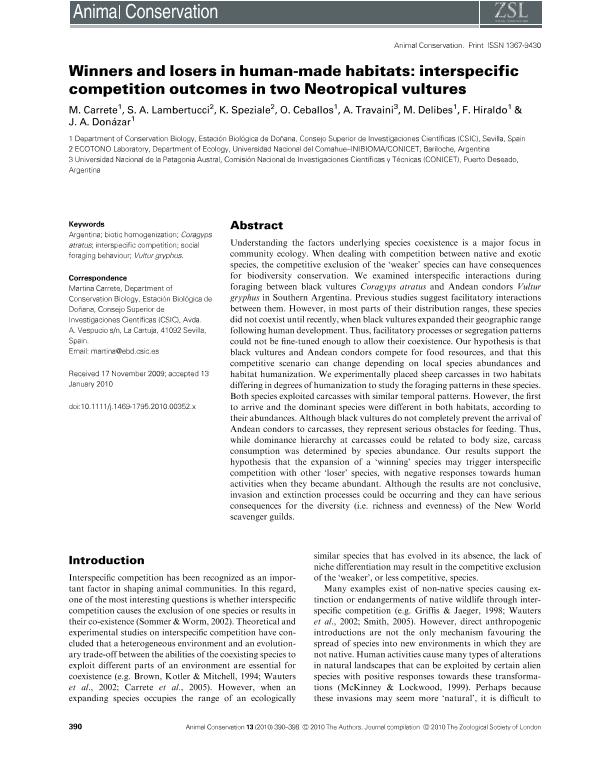Mostrar el registro sencillo del ítem
dc.contributor.author
Carrete, Martina

dc.contributor.author
Lambertucci, Sergio Agustin

dc.contributor.author
Speziale, Karina Lilian

dc.contributor.author
Ceballos, O.
dc.contributor.author
Travaini, Alejandro

dc.contributor.author
Delibes, M.
dc.contributor.author
Hiraldo, F.
dc.contributor.author
Donázar, José Antonio

dc.date.available
2023-02-03T19:51:51Z
dc.date.issued
2010-07
dc.identifier.citation
Carrete, Martina; Lambertucci, Sergio Agustin; Speziale, Karina Lilian; Ceballos, O.; Travaini, Alejandro; et al.; Winners and losers in human-made habitats: Interspecific competition outcomes in two Neotropical vultures; Wiley Blackwell Publishing, Inc; Animal Conservation; 13; 4; 7-2010; 390-398
dc.identifier.issn
1367-9430
dc.identifier.uri
http://hdl.handle.net/11336/186861
dc.description.abstract
Understanding the factors underlying species coexistence is a major focus in community ecology. When dealing with competition between native and exotic species, the competitive exclusion of the 'weaker' species can have consequences for biodiversity conservation. We examined interspecific interactions during foraging between black vultures Coragyps atratus and Andean condors Vultur gryphus in Southern Argentina. Previous studies suggest facilitatory interactions between them. However, in most parts of their distribution ranges, these species did not coexist until recently, when black vultures expanded their geographic range following human development. Thus, facilitatory processes or segregation patterns could not be fine-tuned enough to allow their coexistence. Our hypothesis is that black vultures and Andean condors compete for food resources, and that this competitive scenario can change depending on local species abundances and habitat humanization. We experimentally placed sheep carcasses in two habitats differing in degrees of humanization to study the foraging patterns in these species. Both species exploited carcasses with similar temporal patterns. However, the first to arrive and the dominant species were different in both habitats, according to their abundances. Although black vultures do not completely prevent the arrival of Andean condors to carcasses, they represent serious obstacles for feeding. Thus, while dominance hierarchy at carcasses could be related to body size, carcass consumption was determined by species abundance. Our results support the hypothesis that the expansion of a 'winning' species may trigger interspecific competition with other 'loser' species, with negative responses towards human activities when they became abundant. Although the results are not conclusive, invasion and extinction processes could be occurring and they can have serious consequences for the diversity (i.e. richness and evenness) of the New World scavenger guilds.
dc.format
application/pdf
dc.language.iso
eng
dc.publisher
Wiley Blackwell Publishing, Inc

dc.rights
info:eu-repo/semantics/openAccess
dc.rights.uri
https://creativecommons.org/licenses/by-nc-sa/2.5/ar/
dc.subject
ARGENTINA
dc.subject
BIOTIC HOMOGENIZATION
dc.subject
CORAGYPS ATRATUS
dc.subject
INTERSPECIFIC COMPETITION
dc.subject
SOCIAL FORAGING BEHAVIOUR
dc.subject
VULTUR GRYPHUS
dc.subject.classification
Conservación de la Biodiversidad

dc.subject.classification
Ciencias Biológicas

dc.subject.classification
CIENCIAS NATURALES Y EXACTAS

dc.title
Winners and losers in human-made habitats: Interspecific competition outcomes in two Neotropical vultures
dc.type
info:eu-repo/semantics/article
dc.type
info:ar-repo/semantics/artículo
dc.type
info:eu-repo/semantics/publishedVersion
dc.date.updated
2023-02-02T19:55:04Z
dc.journal.volume
13
dc.journal.number
4
dc.journal.pagination
390-398
dc.journal.pais
Reino Unido

dc.journal.ciudad
Londres
dc.description.fil
Fil: Carrete, Martina. Consejo Nacional de Investigaciones Científicas y Técnicas; Argentina. Consejo Superior de Investigaciones Científicas. Estación Biológica de Doñana; España
dc.description.fil
Fil: Lambertucci, Sergio Agustin. Consejo Nacional de Investigaciones Científicas y Técnicas. Centro Científico Tecnológico Conicet - Patagonia Norte. Instituto de Investigaciones en Biodiversidad y Medioambiente. Universidad Nacional del Comahue. Centro Regional Universidad Bariloche. Instituto de Investigaciones en Biodiversidad y Medioambiente; Argentina
dc.description.fil
Fil: Speziale, Karina Lilian. Consejo Nacional de Investigaciones Científicas y Técnicas. Centro Científico Tecnológico Conicet - Patagonia Norte. Instituto de Investigaciones en Biodiversidad y Medioambiente. Universidad Nacional del Comahue. Centro Regional Universidad Bariloche. Instituto de Investigaciones en Biodiversidad y Medioambiente; Argentina
dc.description.fil
Fil: Ceballos, O.. Consejo Superior de Investigaciones Científicas. Estación Biológica de Doñana; España
dc.description.fil
Fil: Travaini, Alejandro. Consejo Nacional de Investigaciones Científicas y Técnicas; Argentina. Universidad Nacional de la Patagonia Austral. Unidad Académica Caleta Olivia. Centro de Investigaciones Puerto Deseado; Argentina
dc.description.fil
Fil: Delibes, M.. Consejo Superior de Investigaciones Científicas. Estación Biológica de Doñana; España
dc.description.fil
Fil: Hiraldo, F.. Consejo Superior de Investigaciones Científicas. Estación Biológica de Doñana; España
dc.description.fil
Fil: Donázar, José Antonio. Consejo Superior de Investigaciones Científicas. Estación Biológica de Doñana; España
dc.journal.title
Animal Conservation

dc.relation.alternativeid
info:eu-repo/semantics/altIdentifier/url/https://zslpublications.onlinelibrary.wiley.com/doi/10.1111/j.1469-1795.2010.00352.x
dc.relation.alternativeid
info:eu-repo/semantics/altIdentifier/doi/http://dx.doi.org/10.1111/j.1469-1795.2010.00352.x
Archivos asociados
